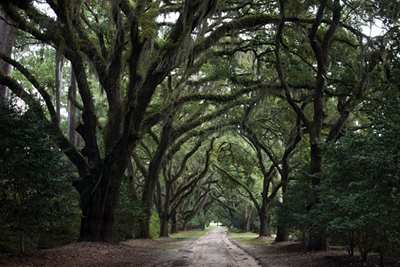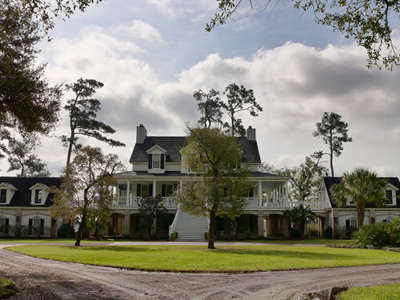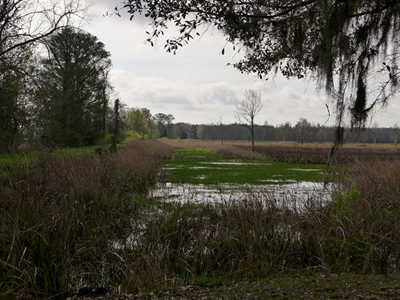Springfield Plantation – Plantersville – Georgetown County
Basic Information
- Location – Plantersville, Pee Dee River, Prince George Winyah Parish, Georgetown County
Located off Plantersville Road between Dirleton Road and Arundel Avenue
- Origin of name – ?
- Other names – Wehaw
- Current status – Privately owned

— Springfield Plantation Avenue of Oaks © Brandon Coffey, 2014 —
(Do Not Use Without Written Consent)
Timeline
- 1729 – Earliest known date of existence (1, p. 299)
The property was deeded to Indian trader William Waties. The property was known as Wehaw (1, p. 299).
- 1735 – Waites sold the 650 acre tract to James Gordon (1, p. 300).
- ? – House built
- 1739 – James Gordon passed away leaving the plantation to his oldest son Cosmus Gordon who was still a minor. Cosmus would never take control of the plantation as the executors of his father's will found it necessary to sell the plantation (1, p. 300).
- 1740 – Alexander Dick purchased the property from Gordon's estate but died soon after. Dick's sister authorized the property be put back up for sale (1, p. 300).
- 1742 – Joseph Shute bought the plantation from the Dick estate and 15 days later sold it to John MacKenzie. MacKenzie was an agent of the Dick estate and these transactions were necessary for him to be able to purchase the plantation (1, p. 300).
- 1750 – John MacKenzie sold to Luke (Lucas) Stoutenbergh (1, p. 301).
- 1764 – Luke Stoutenbergh sold the plantation, undivided, to wife Sarah and step-son John MacKenzie shortly before his death (1, p. 301).
- 1768 – Sarah Stoutenbergh died and left her interest in the plantation to son John MacKenzie (1, p. 301).
- 1771 – John MacKenzie passed away leaving his estate to his young wife Sarah Smith MacKenzie (1, p. 302).
- 1771 – Sarah Smith MacKenzie sold the plantation to Rowlins Lowndes (1, p. 302).
- 1773 – Daniel Huger purchased the tract from Lowndes (1, p. 302).
- 1778 – Daniel Huger sold 800 acres of the plantation to John Huger (1, p. 302).
- 1778 – John Huger held title for only four months and sold it to James Gordon (possibly son of the James Gordon who had owned the property in the early 1700s) for more than double his purchase price (1, p. 302).
- 1786 – William Allston purchased the property from James Gordon (1, p. 303).
- 1789 – William Allston sold to John Splatt Cripps (1, p. 303).
- 1816 – Brothers George and Savage Smith purchased the plantation at a sheriff's sale that noted John S. Cripps had owned it previously (1, p. 303).
- 1825 – Both Smith brothers were dead by 1819 and left several heirs to fight over intermingled estates. The courts would grant the plantation to the heirs of Savage Smith (1, p. 303).
- 1834 – When all of the heirs of Savage Smith where of age, the plantation was sold to Reverend Maurice Harvey Lance. At this time a dwelling as well as twelve servants' houses were documented as being on the plantation. Lance would call the plantation Springfield (1, p. 304).
- ? – Richard O. Anderson was Springfield's next owner (1, p. 304).
- 1853 – Richard O. Anderson died and his executors sold the plantation to Charles Cotesworth Pinckney Alston (1, p. 304).
- 1881 – Charles Pringle Alston and Susan Alston inherited Springfield in this year after the passing of Charles Cotesworth Pinckney Alston (1, p. 304).
- 1897 – Charles Pringle Alston and Susan Alston sold Springfield to Louis Claude Lachicotte (1, p. 304).
- 1899 – Lachicotte sold the property to the Guendalos Rice Company (1, p. 304).
- 1904 – James Louis LaBruce bought the Guendalos Rice Company including Springfield Plantation which he sold to Dudley Pickman (1, p. 304).
- 1930 – A large lodge building may have been constructed at Springfield. This is the house still standing (2015) (2).
- 1940 – Woodlands Plantation, Inc. purchased Springfield from the Pickman's heirs (1, p. 304).
- 2001 – Springfield Plantation was owned by Dr. J. Howard Stokes (1, p. 304).
Land
- Number of acres – 1,130 in 1773; 800 in 1778; 1,025 in 1860 (1)
- Primary crop – Rice
Slaves
- Number of slaves – ?
References & Resources
- Suzanne Cameron Linder and Marta Leslie Thacker, Historical Atlas of the Rice Plantations of Georgetown County and the Santee River
(Columbia, SC: South Carolina Department of Archives and History, 2001)
 Order Historical Atlas of the Rice Plantations of Georgetown County and the Santee River
Order Historical Atlas of the Rice Plantations of Georgetown County and the Santee River - Information contributed by Gazie Nagle.




